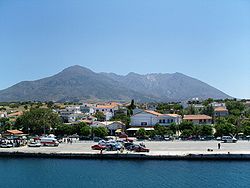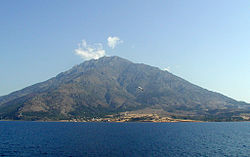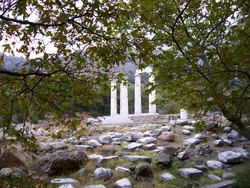
Kamariotissa, the main port of Samothrace.
Samothrace (also Samothraki) (Greek: Σαμοθράκη, pronounced: /samoˈθraci|/) is a Greek island in the northern Aegean Sea. It is a municipality within the Evros regional unit of Thrace. The island is 17 km (11 mi) long and is 178 km2 (69 sq mi) in size and has a population of 2,723 (2001 census). Its main industries are fishing and tourism. Resources on the island includes granite and basalt. Samothrace is one of the most rugged Greek islands, with Mt. Fengari rising to 1,611 m.
History[]
Antiquity[]

The Winged Victory of Samothrace, one of the best-known ancient Greek statues.
Samothrace was not a state of any political significance in ancient Greece, since it has no natural harbour and most of the island is too mountainous for cultivation: Mount Fengari (literally 'Moon Mt') rises to 1,611 m (5,285 ft). It was, however, the home of the Sanctuary of the Great Gods, site of important Hellenic and pre-Hellenic religious ceremonies. Among those who visited this shrine to be initiated into the island cult were Lysander of Sparta, Philip II of Macedon and Lucius Calpurnius Piso Caesoninus, father-in-law of Julius Caesar.
The ancient city, the ruins of which are called Palaeopoli ("old city"), was situated on the north coast. Considerable remains still exist of the ancient walls, which were built in massive Cyclopean style, as well as of the Sanctuary of the Great Gods, where mysterious rites took place which were open to both slaves and free people (similar to the Eleusinian Mysteries).
The traditional account from antiquity is that Samothrace was first inhabited by Pelasgians and Carians, and later Thracians. At the end of the 8th century BCE the island was colonised by Greeks from Samos, from which the name Samos of Thrace, that later became Samothrace; although Strabo denies this. The archaeological evidence suggests that Greek settlement was in the sixth century BCE.

Waterfall and pond in Samothrace.
The Persians occupied Samothrace in 508 BCE, it later passed under Athenian control, and was a member of the Delian League in the 5th century BCE. It was subjected by Philip II, and from then till 168 BC it was under Macedonian suzerainty. With the battle of Pydna Samothrace became independent, a condition that ended when Vespasian absorbed the island in the Roman Empire in 70 CE.
The Book of Acts in the Christian Bible records that the Apostle Paul, on his second missionary journey outside of Palestine, sailed from Troas to Samothrace and spent one night there on his way to Macedonia. [1]
Post-Roman Era[]

Samothrace, with Mt. Fengari in the background.
St. Theophanes died in Samothrace in 818. The Byzantines ruled till 1204, when Venetians took their place, only to be dislodged by a Genoan family in 1355, the Gattilusi. The Ottoman Empire conquered it in 1457 and it was called Semadirek in Turkish; an insurrection against them by the local population during the Greek War of Independence (1821–1831) led to the massacre of 1,000 inhabitants.[2] The island returned to Greek rule in 1913 following the Balkan War. It was briefly occupied by Bulgaria during the Second World War.
Today[]
The modern port town of Kamariotissa is on the north-west coast and provides ferry access to and from points in northern Greece such as Alexandroupoi and Kavala. There is no commercial airport on the island. Other sites of interest on the island include the ruins of Genoese forts, the picturesque Chora (literally village) and Paliapoli (literally Old Town), and several waterfalls.
Landmarks[]

A picturesque view of the Hieron

One of the numerous ponds characteristic of the island.
The island's most famous site is the Sanctuary of the Great Gods, Greek Hieron ton Megalon Theon ; the most famous artifact of which is the 2.5-metre marble statue of Nike, now known as the Winged Victory of Samothrace, dating from about 190 BCE. It was discovered in pieces on the island in 1863 by the French archaeologist Charles Champoiseau, and is now - headless - in the Louvre in Paris.
Communities[]
- Alonia (pop. 251)
- Ano Karyotes (15)
- Ano Meria (58)
- Dafnes (11)
- Kamariotissa (969)
- Kato Karyotes (37)
- Katsampas (12)
- Lakkoma (329)
- Makrylies (9)
- Mpaxedes (0)
- Pahia Ammos
- Palaiopoli (25)
- Potamia (3)
- Profitis Ilias (214)
- Remboutsadika
- Samothrace/Samothraki (677)
- Therma (74)
- Xiropotamos (39)
Province[]
The province of Samothrace (Greek:Επαρχία Σαμοθράκης) was one of the provinces of the Evros Prefecture. It had the same territory as the present municipality.[3] It was abolished in 2006.
Historical population[]
| Year | Island population |
|---|---|
| 1981 | 2,871 |
| 1991 | 3,083 |
| 2001 | 2,723 |
| 2011 | 2,840 (preliminary data) [4] |
References[]
- ↑ Acts 16:11
- ↑ Charles Vellay, L'irrédentisme hellénique, 1913, 329 pages. page 131: [1]
- ↑ Detailed census results 1991PDF (39 MB) (Greek) (French)
- ↑ http://www.statistics.gr/portal/page/portal/ESYE/BUCKET/General/A1602_SAM01_DT_DC_00_2011_01_F_GR.pdf
- Michel Mourre, Dictionnaire Encyclopédique d'Histoire, article Samothrace, Bordas, 1996
- Marcel Dunan, Histoire Universelle, Larousse, 1960
External links[]
 Media related to Samothraki on Wikimedia Commons
Media related to Samothraki on Wikimedia Commons
| This page uses content from the English Wikipedia. The original article was at Samothrace. The list of authors can be seen in the page history. |